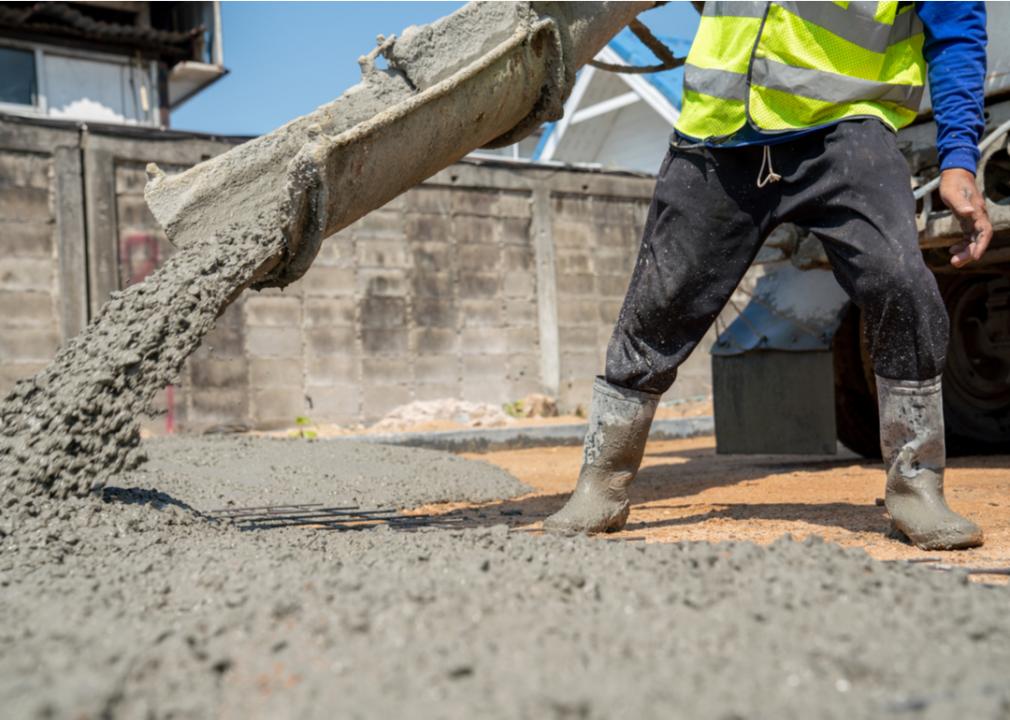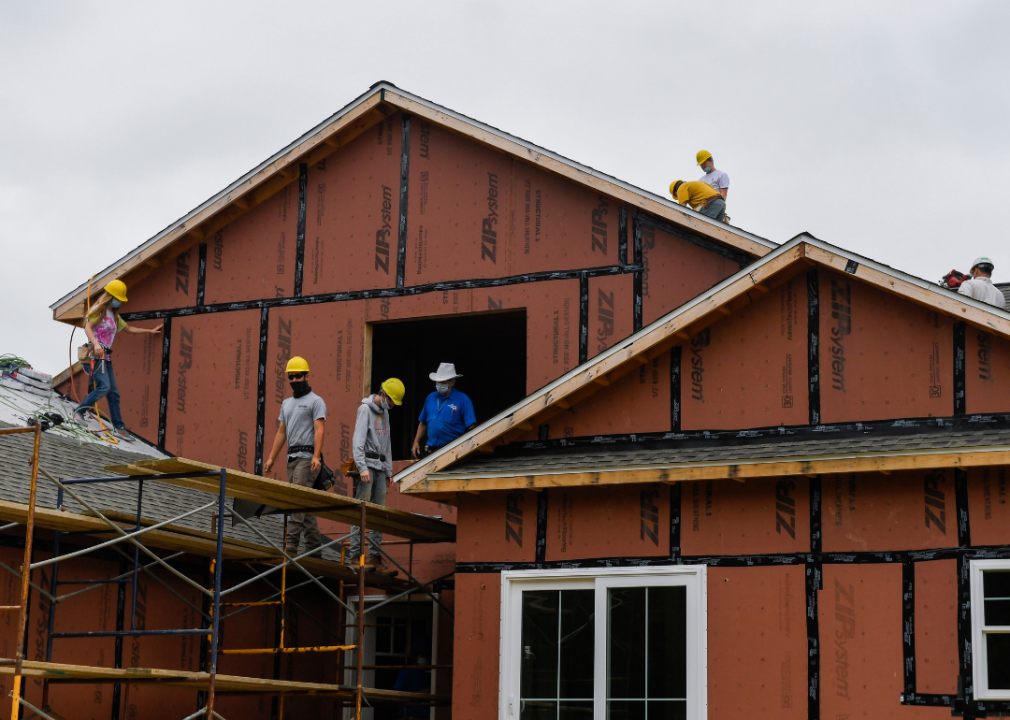Industries with the most new small businesses

21MARCH // Shutterstock
Industries with the most new small businesses
To say that the U.S. economy was affected by the ongoing pandemic would be an understatement. In the early months, shutdowns caused tremendous damage for businesses of all sizes. In turn, employees were laid off, furloughed, or sent home to work remotely, forever changing the landscape of how Americans work.
Things have gotten better since those days. The widespread availability of COVID-19 vaccines has made it easier for businesses to grow, thrive, and employ. And, while furloughs and layoffs were at one point all too common, a lack of workforce to fill empty jobs has now become the norm as job seekers shift their sights to look for better opportunities and higher paychecks. In fact, recent data showed that the United States now has more job openings than at any time in history, and the trend is likely to continue—at least in the near future.
An abundance of open jobs is hardly the only lasting effect the coronavirus has had on business, though. One of the most significant shifts to the U.S. economy was a surprising new growth in small businesses, which are popping up in nearly every industry. While these businesses may have a tough time filling open job requisites right now, it doesn’t seem to be stopping the growth. Not in certain industries, anyway. But what industries are seeing the most significant growth in new small businesses?
Using Business Formation data from the U.S. Census Bureau, SimplyBusiness broke down the industries with the most new business applications. Businesses were categorized by the Census Bureau based on their NAICS 3-digit code, indicating subsector, and ranked by the total number of new business applications submitted between Jan. 1, 2019, and Oct. 4, 2020. The average number of new businesses per week were also included—but the data only goes through Oct. 4, 2020, so it’s important to note this is an imperfect view of how business applications changed during the coronavirus. Here’s what that data showed about the industries with the most new small-business growth.
![]()

Monkey Business Images // Shutterstock
#15. Educational services
– Total of new businesses, Jan. 1, 2019–Oct. 4, 2020: 79,020
– Average number of new businesses per week, Jan. 1, 2019–Oct. 4, 2020: 859
The job market was put through the ringer at the start of the coronavirus, with millions of people either leaving their jobs due to furloughs and layoffs or to pursue new employment avenues altogether. In turn, this led to increased demand for educational services as people sought out innovative ways to transition their careers with the help of business, technical, and trade schools.
And, the widespread public school closures that occurred early in the pandemic likely added to the subsequent growth within educational services: Parents who were concerned about the quality of their children’s remote learning sought out tutoring and other educational support systems. There was also an uptick in demand for online homeschooling programs as parents sought out safer alternatives to in-person learning, which contributed to growth in this industry. On a single day in July 2020, the National Home School Association said it got over 3,400 information inquiries—prior to the pandemic, the organization received five to 20 requests per day.

Jono Erasmus // Shutterstock
#14. Amusement, gambling, and recreation industries
– Total of new businesses, Jan. 1, 2019–Oct. 4, 2020: 79,760
– Average number of new businesses per week, Jan. 1, 2019–Oct. 4, 2020: 867
Boredom and restlessness caused by the coronavirus stay-at-home orders and closures led Americans to flock to any and all of the open and accessible recreation options in 2020. That was especially true of outdoor recreational activities, which were some of the safest entertainment options. Camping, fishing, hunting, hiking, cycling, running, swimming, and other outdoor activities were all in high demand.
In turn, amusement and recreation attendant jobs, as well as fitness trainer and aerobics instructor jobs, were plentiful as new businesses in these industries opened to meet increased demand. Growth in supplier businesses surged, thanks to an increased demand for outdoor and recreation equipment like kayaks and bikes, helping to further the growth of this industry

Michele Rinaldi // Shutterstock
#13. Repair and maintenance
– Total of new businesses, Jan. 1, 2019–Oct. 4, 2020: 113,960
– Average number of new businesses per week, Jan. 1, 2019–Oct. 4, 2020: 1,239
The stay-at-home orders also helped to propel growth in the repair and maintenance industry. This industry includes a wide range of professions, like automotive repair and maintenance and home maintenance. This also includes painters and home improvement installation, repair, and maintenance workers.
The growth in this industry was due, in large part, to a nationwide shift to remote work, which led to more people prioritizing home repairs and projects. That, coupled with the recent uptick in homeownership, led new businesses to help fill in the gaps left by the increased demand. The ongoing housing shortage also likely added to the rapid growth, as homeowners snatched up houses in all markets—and in all conditions—across the nation.

riopatuca // Shutterstock
#12. Social assistance
– Total of new businesses, Jan. 1, 2019–Oct. 4, 2020: 120,120
– Average number of new businesses per week, Jan. 1, 2019–Oct. 4, 2020: 1,306
The social assistance industry, which includes child day care services, vocational rehabilitation services, and community housing, food, and emergency relief services, also saw an uptick in new small businesses. The growth in this industry likely occurred for a few different reasons.
With millions of school districts shifting to temporary remote learning environments, there would have been an increased need for child day care services by parents balancing work and child care. Plus, the need for housing and food assistance was much higher than normal after widespread furloughs and layoffs took hold across the nation. An increase in demand for vocational rehabilitation services was almost certainly another contributor to the growth in this industry, as millions of people were in search of alternative career paths after shutdowns and job cuts became commonplace.

fizkes // Shutterstock
#11. Religious, grant-making, civic, professional, and similar organizations
– Total of new businesses, Jan. 1, 2019–Oct. 4, 2020: 142,080
– Average number of new businesses per week, Jan. 1, 2019–Oct. 4, 2020: 1,544
The religious, grant-making, civic, professional, and similar organizations experienced an explosion of new small-business growth recently, and much of it stems from the coronavirus. Thanks to a dwindling economy and tough job prospects, consumers placed high demand on this industry, which includes businesses that organize and promote religious activities; support various causes through grant-making; advocate various social and political causes; and promote and defend the interests of their members. There was a significant need for these types of services as millions of people struggled to make ends meet, pay bills, and keep roofs over their heads. The pandemic also caused severe social and emotional stress for the nation, which led to an uptick in demand for remote religious support. These factors led to a growth in new small businesses across this sector to help meet people’s needs during a trying time.

Marmolejos // Shutterstock
#10. Ambulatory health care services
– Total of new businesses, Jan. 1, 2019–Oct. 4, 2020: 184,440
– Average number of new businesses per week, Jan. 1, 2019–Oct. 4, 2020: 2,005
The ambulatory health care services industry—which includes offices for physicians, dentists, and health practitioners, as well as outpatient care centers, diagnostic labs, and home health care—has also had significant small-business growth, and for obvious reasons. The demand for health care has been extremely high since the start of the pandemic, especially during the early months, when there was uncontrolled spread of the coronavirus. The need for more diagnostic labs also dramatically increased thanks to widespread COVID-19 testing. Other nonpandemic-related issues, such as a rapidly aging population or a need for more telehealth options, have likely contributed to the growth of small businesses in this industry

Bannafarsai_Stock // Shutterstock
#9. Specialty trade contractors
– Total of new businesses, Jan. 1, 2019–Oct. 4, 2020: 221,430
– Average number of new businesses per week, Jan. 1, 2019–Oct. 4, 2020: 2,407
The specialty trade contractors industry consists of building construction contractors with special skills—like pouring concrete, site preparation, plumbing, painting, and electrical work—who are not responsible for the entire project. This industry has exploded with new small businesses recently, as these contractors are in high demand due to the ongoing housing shortage. Builders still can’t keep up with demand in any market, which has made this a prime time for new businesses to capitalize on the growth in the industry. Other factors, like the increased demand for contractors specializing in home remodeling projects, has also helped this industry grow at a rapid pace. The increased demand for investment properties by flippers and landlords has also contributed to the growth of new small businesses in this industry—and will almost certainly continue to help drive the trend in the future as well.

Aleksandar Malivuk // Shutterstock
#8. Truck transportation
– Total of new businesses, Jan. 1, 2019–Oct. 4, 2020: 297,620
– Average number of new businesses per week, Jan. 1, 2019–Oct. 4, 2020: 3,235
The shutdowns early in the pandemic had a big impact on the truck transportation industry. This industry, which specializes in providing over-the-road cargo transportation by trucks and tractor trailers, came to a halt as the sluggish economy caused consumer spending to dwindle. With the decreased demand for truckers to ferry shipments across the nation, trucking businesses closed across the nation. But things changed rapidly as the shutdowns eased, causing the demand for truckers to increase once again—and a shortage occurred. This led to an uptick in new small trucking ventures as new businesses in the truck transportation industry swooped in to help fill the void.

ivan_kislitsin // Shutterstock
#7. Personal and laundry services
– Total of new businesses, Jan. 1, 2019–Oct. 4, 2020: 301,280
– Average number of new businesses per week, Jan. 1, 2019–Oct. 4, 2020: 3,275
The personal and laundry services industry, which includes laundry services, pet care services, photofinishing services, temporary parking services, and dating services, has also had a significant increase in new businesses. At least some of that growth can be attributed to a high demand for dating services during the coronavirus. As social distancing rules closed bars and shuttered traditional singles spots, activity surged on dating apps. Pet care services were also in high demand as remote work led to people spending more time with their pets. In both cases, tons of new small businesses were able to capitalize on an increased demand, whether it was for dog walking, grooming, doggy day care, or digital dating.

Monkey Business Images // Shutterstock
#6. Food services and drinking places
– Total of new businesses, Jan. 1, 2019–Oct. 4, 2020: 332,350
– Average number of new businesses per week, Jan. 1, 2019–Oct. 4, 2020: 3,613
There is no question that the pandemic has been rough on restaurants and bars. According to Fortune, more than 110,000 eating and drinking establishments closed in 2020, as shutdowns made it tough for businesses in this industry to make a profit or pay bills. That changed as the shutdowns eased and the demand for open bars and restaurants surged, which led to some new small businesses opening for service. But it wasn’t just the sit-down establishments that caused the uptick in new businesses. Other types of food services helped drive the increase, including mobile food services, which grew by leaps and bounds while in-person dining was closed to guests across the nation. Other types of mobile food services, like food trucks, also helped to drive the new growth, as these types of businesses were able to cater to patrons even during the shutdowns.

MediaNews Group/Readig Eagle // Getty Images
#5. Construction of buildings
– Total of new businesses, Jan. 1, 2019–Oct. 4, 2020: 343,390
– Average number of new businesses per week, Jan. 1, 2019–Oct. 4, 2020: 3,733
The building construction industry has also grown significantly, and it’s due in no small part to the housing shortage further amplified by the coronavirus. Extremely low mortgage rates drove a buying frenzy at the start of the pandemic, and it has continued ever since. This caused a housing shortage in nearly all markets, and a significant surge in demand for new construction caused the market to tighten even further. The demand is so high, in fact, that builders can’t keep up—despite the increasing cost of building materials. Buyers are offering well above asking price, and homes are going under contract at lightning speed—and that includes newly constructed homes. With established building construction businesses struggling to keep up with demand, the doors have opened for new businesses in this industry to thrive.

wavebreakmedia // Shutterstock
#4. Real estate
– Total of new businesses, Jan. 1, 2019–Oct. 4, 2020: 349,990
– Average number of new businesses per week, Jan. 1, 2019–Oct. 4, 2020: 3,804
The real estate industry, which includes businesses focused on renting or leasing real estate to others; managing real estate for others; selling, buying, or renting real estate for others; and providing other real estate related services, such as appraisal services, has had some of the most significant new small-business growth. As with building construction and other related industries, much of the growth has come from low mortgage rates fueling a buying frenzy. Real estate agents are busier than ever as the pandemic exacerbated the strain on housing in the United States, particularly when it comes to rentals. Other related services, like home appraisals and inspectors, are also in high demand, as these services are necessary during the buying process. And, the ongoing demand now means that new businesses in these areas can find quick success—which has led to significant growth of new small businesses in this industry.

chainarong06 // Shutterstock
#3. Administrative and support services
– Total of new businesses, Jan. 1, 2019–Oct. 4, 2020: 444,250
– Average number of new businesses per week, Jan. 1, 2019–Oct. 4, 2020: 4,829
The administrative and support services industry, which provides support for the day-to-day operations of other organizations or households, has also had significant growth in small businesses. Part of the growth has been due to the increased need for employment services, which have been in demand since the start of the pandemic. After shutdowns caused mass layoffs and furloughs, millions of Americans were seeking jobs—and many turned to employment services for help. That tide has shifted recently, however, with a lack of workers to fill jobs across the nation, and now businesses are looking for innovative ways to fill open positions. This has led to an uptick in new employment service businesses. That, coupled with more demand for help around the home from remote workers—and a need for administrative services from companies struggling to fill open jobs—has led to an explosion of new small businesses in this industry.

Dragon Images // Shutterstock
#2. Professional, scientific, and technical services
– Total of new businesses, Jan. 1, 2019–Oct. 4, 2020: 709,440
– Average number of new businesses per week, Jan. 1, 2019–Oct. 4, 2020: 7,711
The professional, scientific, and technical services industry is filled with niche subsectors that specialize in performing professional, scientific, and technical activities for others. This includes scientific research and development services, which are increasingly necessary thanks to the ongoing public health crisis. That alone has helped to drive more new small businesses to open in this industry, as scientific services have been essential to help monitor and research issues related to the coronavirus. That isn’t the only recent driver of small-business growth in this industry, however. Other factors, like the now-thriving economy, have also helped contribute to new small-business growth in this industry, as healthy economies generally cause an increased demand for specially trained services, like accountants, consultants, and other highly specialized experts. This has led to opportunities for new businesses across almost all subsegments of this industry.

Poring Studio // Shutterstock
#1. Nonstore retailers
– Total of new businesses, Jan. 1, 2019–Oct. 4, 2020: 764,190
– Average number of new businesses per week, Jan. 1, 2019–Oct. 4, 2020: 8,306
While many other industries have seen significant growth recently, the fastest new-business growth has occurred in the nonstore retailer industry. This industry focuses on selling retailer goods through methods such as infomercials, direct-response advertising, paper and electronic catalogs, door-to-door solicitation, in-home demonstration, and other similar methods. A large part of this growth can be attributed to layoffs and furloughs, which led people to look for alternative revenue streams, like direct selling through multilevel marketing, or MLM, companies. The profits for these companies, which offer everything from herbal supplements to makeup to clothing items, grew vastly during the pandemic, and it led to new small businesses popping up in this industry at a rapid pace. The demand for health supplements, training, and other fitness-related goods also helped to push the momentum, as people sought out ways to get fit or stay healthy during the lockdowns. A captive audience filled with locked-down residents in nearly every market also helped to drive growth, as it became easier to sell to consumers via these methods—which only added more fuel to the new small-business fire in this industry.
This story originally appeared on SimplyBusiness
and was produced and distributed in partnership with Stacker Studio.




